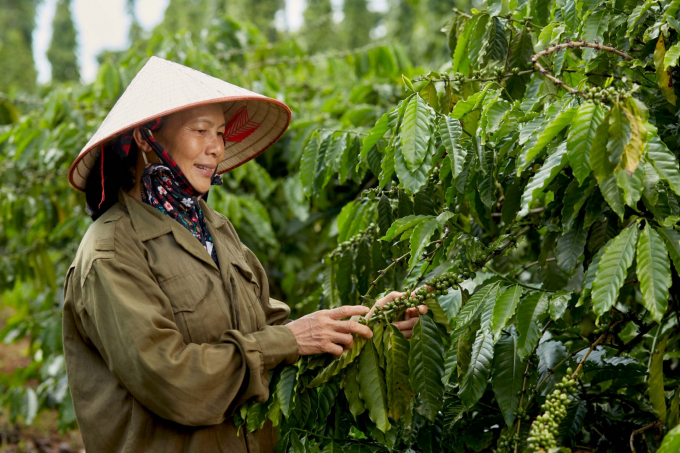November 27, 2025 | 01:42 GMT +7
November 27, 2025 | 01:42 GMT +7
Hotline: 0913.378.918
November 27, 2025 | 01:42 GMT +7
Hotline: 0913.378.918

Nestlé Vietnam CEO Binu Jacob.
Nestlé Group officially returned to Vietnam with the establishment of Nestlé Vietnam in 1995 and continuously expanded investment and diversified products. Up to now Nestlé's total investment capital in Vietnam has reached USD 730 million.
Nestlé pioneers activities towards regenerative agriculture through the NESCAFÉ Plan in Vietnam. Since its launch in 2011, NESCAFÉ Plan has distributed more than 53 million high-yielding, drought-resistant coffee seedlings to farmers and rehabilitated 53,000 ha of coffee in the Central Highlands. The project also organized more than 300,000 training courses on sustainable coffee farming techniques for 300,000 farmers, helping 21,000 farmers achieve 4C international coffee certification.
Through the NESCAFÉ Plan, our agricultural engineers have collaborated with domestic and foreign scientific organizations and agricultural experts to carry out the following specific actions:
Protect soil health and color: Regenerative farming practices contribute to soil protection by reducing the amount of inorganic fertilizers, increasing the use of organic fertilizers and composting from coffee husks and post-harvest by-products. By applying this farming method, farmers can reduce about 20-30% of inorganic fertilizers, thereby improving fertility and improving soil health.
Protect groundwater resources: Regenerative farming practices help protect increasingly scarce groundwater resources. The NESCAFÉ Plan project has introduced water-saving irrigation techniques including drip irrigation, sprinkler irrigation or using a simple, easy to find and inexpensive tools such as cow milk cans or plastic water bottles to measure the moisture level in the soil. These measures help farmers save 40%-60% of the water required to irrigate coffee trees compared to before.
Protect biodiversity: Nestlé Vietnam develops regenerative agriculture with a reasonable intercropping model such as growing pepper with coffee. In particular, pepper is a shade tree and a windbreak, so if only 30% of pepper trees are intercropped into a coffee garden, the amount of carbon absorbed into the soil will be higher than the emission.
Nestlé Vietnam has cooperated with the Western Highlands Agriculture and Forestry Science Institute (WASI) to produce new high-yielding, pest and drought resistant coffee varieties to distribute to farmers. The use of healthy, disease-free coffee varieties, combined with a reasonable intercropping model, contributes to improving farmers' incomes as well as ensuring a supply of good quality coffee for Nestlé Vietnam's factories.
Reduce greenhouse gas emissions in coffee farming: Nestlé Vietnam work with international organizations to manage greenhouse gas emissions in coffee farming and aim to reduce the emission rate in coffee farming to the lowest possible. All of the above activities are aimed at contributing toward the goal of net-zero emissions in agriculture.
I believe the Government, MARD and localities in Vietnam are increasingly paying attention to sustainable agriculture. Agro-products are also produced in a more responsible manner. This is a very encouraging thing and also the right direction for future development.

Farmers actively participate in the NESCAFÉ Plan.
In order to promote green, sustainable and responsible agricultural models, we need to start with the basics, which are changing farming mindset, farming habits, and organizing and support mechanisms.
This thus calls for policies to support and encourage more and more farmers and communities to transition from less sustainable production methods to more modern and sustainable production methods, helping to conserve, restore, and regenerate the land and ecosystems associated with these new methods.
Management agencies need to perfect the mechanism and application of biological plant protection drugs, apply digital transformation in the management of guidelines for effective, safe and responsible use of pesticides, strengthen public-private cooperation in production, replicate farming models to reduce production costs while ensuring productivity and agro-products quality, and promote the reorganization of commodity sectors in agroproduction.
Nestlé is ready to work with our partners to realize these goals toward a green and regenerative agriculture. With a long-term commitment we have been working closely with coffee farmers for over 11 years. We will continue to support farmers in the Central Highlands with more sustainable farming knowledge, improve the quality of Vietnamese coffee beans, and promote regenerative agriculture through the NESCAFÉ Plan.
I believe the Vietnam market can completely become a production center for packaged food and beverage products for the whole world thanks to a skilled workforce and high work ethic. One thing to note is that Nestlé Vietnam's operating system is currently among the most efficient and flexible in all markets in which Nestlé is present.
Translated by Samuel Pham
/2025/11/26/4909-2-154329_878.jpg)
(VAN) Pearl grouper farming in HDPE cages not only delivers economic efficiency but also contributes to protecting the environment, creating jobs, and promoting marine-based experiential tourism.

(VAN) The model of making a living under the forest canopy through the agroforestry system in Van Son commune, Bac Ninh province, is expected to generate an annual income of approximately VND 30 million/ha.

(VAN) Many enterprises in Can Tho are harnessing natural energy and reducing greenhouse gas emissions in their production processes, thereby contributing to the promotion of a sustainable green transition.
/2025/11/24/3536-2-112800_176.jpg)
(VAN) Dong Nai now has tens of thousands of hectares of forests certified for sustainable management, and this area will continue to be expanded in the coming period.

(VAN) Vinh Ha hamlet (Dai Xuyen commune, Hanoi) is shifting away from small-scale farming as households adopt bioscurity into their breeder chicken models.

(VAN) Heavy rains make aquatic species more vulnerable to disease. Proactive water management and high-tech systems help farmers prevent outbreaks and protect yields.

(VAN) Greenhouses are shifting production mindsets in Binh Lu commune, enabling farmers to ‘weather the sun and rain’ and secure stable vegetable harvests throughout the year.